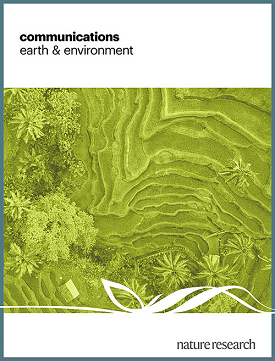城市树木的降温效果由背景气候、城市形态和树木特性决定
IF 8.1
1区 地球科学
Q1 ENVIRONMENTAL SCIENCES
引用次数: 0
摘要
城市规划者和其他利益相关者通常将树木视为缓解城市热压力的终极灵丹妙药;然而,它们的降温效果在全球范围内存在差异,并受到三个主要因素的影响:树木特征、城市形态和气候条件。本研究分析了全球110个城市或地区17种气候条件下城市树木降温效果的182项研究。在83%的城市,树木的实施将月最高气温降至26°C以下。树木可以通过阻挡大量的辐射和蒸腾作用,将行人的温度降低12°C。在热带、温带和大陆性气候中,在开阔的城市形态中混合使用落叶乔木和常绿乔木比单一树种方法提供约0.5°C的降温效果。在干旱气候中,常绿物种占主导地位,并在紧凑的城市形态中表现出更有效的冷却。我们的研究为城市规划者在面对全球变暖的情况下利用树木降温提供了具体的绿化指导方针。根据一项对182项研究的全球荟萃分析,城市树木可以将行人水平的空气温度降低高达12摄氏度,降温效果取决于背景气候、城市形态和树木特征。本文章由计算机程序翻译,如有差异,请以英文原文为准。

Cooling efficacy of trees across cities is determined by background climate, urban morphology, and tree trait
Urban planners and other stakeholders often view trees as the ultimate panacea for mitigating urban heat stress; however, their cooling efficacy varies globally and is influenced by three primary factors: tree traits, urban morphology, and climate conditions. This study analyzes 182 studies on the cooling effects of urban trees across 17 climates in 110 global cities or regions. Tree implementation reduces peak monthly temperatures to below 26 °C in 83% of the cities. Trees can lower pedestrian-level temperatures by up to 12 °C through large radiation blockage and transpiration. In tropical, temperate, and continental climates, a mixed-use of deciduous and evergreen trees in open urban morphology provides approximately 0.5 °C more cooling than a single species approach. In arid climates, evergreen species predominate and demonstrate more effective cooling within compact urban morphology. Our study offers context-specific greening guidelines for urban planners to harness tree cooling in the face of global warming. Urban trees can lower pedestrian-level air temperature by up to 12 degrees centigrade, and the cooling efficacy depends on background climate, urban morphology, and tree trait, according to a global meta-analysis of 182 studies.
求助全文
通过发布文献求助,成功后即可免费获取论文全文。
去求助
来源期刊

Communications Earth & Environment
Earth and Planetary Sciences-General Earth and Planetary Sciences
CiteScore
8.60
自引率
2.50%
发文量
269
审稿时长
26 weeks
期刊介绍:
Communications Earth & Environment is an open access journal from Nature Portfolio publishing high-quality research, reviews and commentary in all areas of the Earth, environmental and planetary sciences. Research papers published by the journal represent significant advances that bring new insight to a specialized area in Earth science, planetary science or environmental science.
Communications Earth & Environment has a 2-year impact factor of 7.9 (2022 Journal Citation Reports®). Articles published in the journal in 2022 were downloaded 1,412,858 times. Median time from submission to the first editorial decision is 8 days.
 求助内容:
求助内容: 应助结果提醒方式:
应助结果提醒方式:


